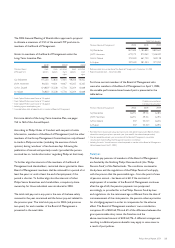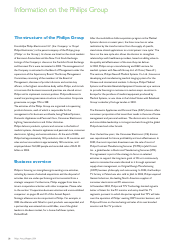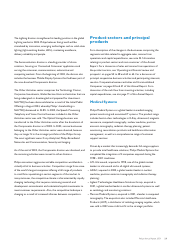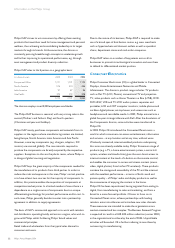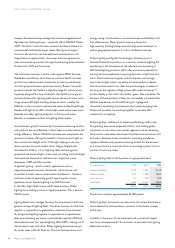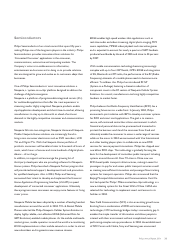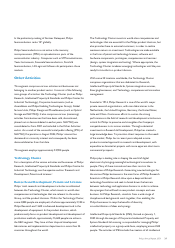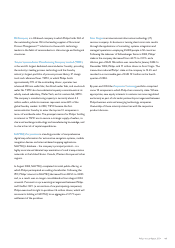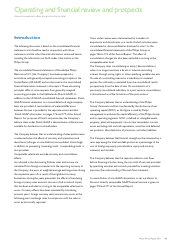Philips 2004 Annual Report Download - page 35
Download and view the complete annual report
Please find page 35 of the 2004 Philips annual report below. You can navigate through the pages in the report by either clicking on the pages listed below, or by using the keyword search tool below to find specific information within the annual report.
compact fluorescent lamps (integrated and non-integrated) and
high-intensity discharge lamps – especially (Mini) MASTER Colour
CDM. The latter solves the color variation problems inherent in
conventional metal-halide lamps, while offering much longer
economic life and thus considerably lower maintenance costs.
Organized on a regional basis, the Lamps business operates its
sales and marketing activities through the following three channels:
Professional, OEM and Consumer.
The Luminaires business is active in the regions EMEA (Europe,
Middle East and Africa), Latin America and Asia Pacific, and sells
products via trade business (commodity products) and directly
into final projects business (special products). Recent successful
products include: the Cabana, a high-bay range for industrial use,
especially designed for easy installation; the OptiFlood range, an
innovative fixture for lighting public spaces and sports areas; and a
range of new LED (light-emitting diode) products, notably the
LEDline2, a new concept to enhance the texture of building/bridge
facades with light from LEDs, which helps make urban areas more
beautiful and offers lighting designers, architects and urban
planners a complete tool box for lighting urban spaces.
In Automotive, growth is driven by innovations enhancing comfort
and safety on the road. Because of their superior performance and
energy efficiency, Xenon HID bulbs have become accepted as the
premium car lamp, offering the benefits of twice as much light on
the road and the daylight color of the light, helping to shorten
driver reaction time and combat driver fatigue. NightGuide,
introduced in 2004, is a 3-in-1 lighting safety technology that
projects three zones of light on the road, providing controlled light
and maximum illumination. Automotive is organized in two
businesses: OEM and After-market.
In Special Lighting – which contains applications such as
stage/theatre/entertainment, infrared for industrial use, and
ultraviolet for both solaria and air/water disinfection – the focus
continues to be on exploiting growth opportunities in new
application areas. Special Lighting is an OEM business.
In the Ultra High Performance (UHP) lamp business, Philips
Lighting has a leading position in digital projection. This is also an
OEM business.
Lighting Electronics manages the lamp driver business in both the
general and special lighting fields. The driver business for the latter
segment is organized on a global basis, while the driver business
for the general lighting segment is organized on a regional basis.
Sales and marketing are mainly conducted through the OEM and
wholesale channels (for special lighting 100% OEM), making use of
shared sales forces with other Philips Lighting businesses except
for driver sales in North America. The main business focus is on
energy saving, miniaturization, increased power and flexibility, and
cost-effectiveness. Major growth areas are drivers for
high-intensity discharge lamps and ultra-high-pressure lamps, as
well as geographical expansion in Asia and Eastern Europe.
Philips Lighting and Agilent Technologies (formerly part of
Hewlett-Packard) are partners in a venture, Lumileds Lighting B.V.,
specializing in the development, manufacture and marketing of
LED-based lighting products. LEDs offer enormous potential for
existing and new applications requiring dynamics in light level and
color. Their small size, long life, instant response, increasingly
more vibrant light output, durability and semiconductor-based
nature set them apart from other lamp technologies. Lumileds is
focusing on the segment of high-power LEDs with its LuxeonTM
product family in the colors red, amber, green, blue and white. On
the basis of these products, Philips has successfully introduced the
LEDline (see above) and the LED String for signage and
decoration, expanding its presence in this rapidly emerging area.
Philips and Lumileds are working together to develop LED
modules for car lighting.
Philips Lighting’s ambition is to achieve profitable growth in the
fast-growing economies (especially China), with leading global
customers, in innovative new market segments and by enhancing
the position in the value chain towards professional customers and
end-users. End-user-driven innovation, marketing excellence,
supply excellence and people are the key drivers for the business
as it moves forward. It will also focus on pursuing a policy of strict
control of costs and assets.
Philips Lighting sales to third parties on a geographic basis:
(in millions of euros) 2002 2003 2004
Europe and Africa 2,128 2,065 2,110
North America 1,242 1,098 1,051
Latin America 411 328 322
Asia Pacific 1,064 1,031 1,043
4,845 4,522 4,526
The division employs approximately 44,000 people.
Philips Lighting’s businesses are seasonal to the extent that there is
more demand for the businesses’ products in the darker months
of the year.
Volatility in the prices of raw materials such as steel and copper
may have consequences for this business, in particular the Lighting
Electronics activity.
34 Philips Annual Report 2004
Information on the Philips Group



